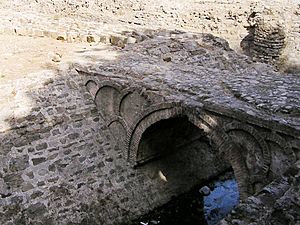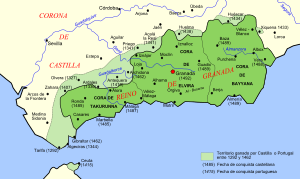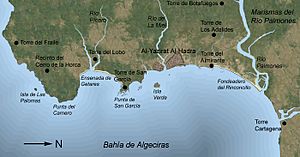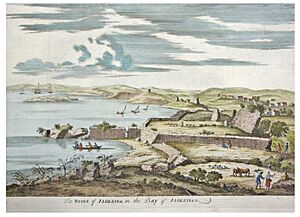Siege of Algeciras (1369) facts for kids
Quick facts for kids Siege of Algeciras (1369) |
|||||||
|---|---|---|---|---|---|---|---|
| Part of the Reconquista | |||||||
 Bridge of access to Al-Yazirat Al-Hadra |
|||||||
|
|||||||
| Belligerents | |||||||
| Commanders and leaders | |||||||
The Siege of Algeciras (1369) was a short but important battle. It happened during the Reconquista, a long period when Christian kingdoms took back land from Muslim rule in Spain. In this siege, Muhammed V, Sultan of Granada, led his forces to recapture the city of Algeciras.
The city, known as Al-Hadra Al-Yazirat to Muslims, had been controlled by the Kingdom of Castile (a Christian kingdom) since 1344. That's when Alfonso XI of Castile captured it after a very long siege. Muhammed V's victory in 1369 was quick, lasting only three days. Ten years later, in 1379, the city was completely destroyed. This was done to prevent it from ever falling back into Christian hands.
Contents
Why Algeciras Was Important
The city of Algeciras has a long history. It was one of the first cities founded by Muslims in Spain. This happened under the leader Tariq ibn Ziyad on the ruins of an old Roman city.
For centuries, Algeciras was important because of its location. It controlled access to the Strait of Gibraltar. This narrow waterway connects the Atlantic Ocean to the Mediterranean Sea. Because of this, both Muslim and Christian rulers wanted to control it.
In 1344, after a two-year siege, the Christian king Alfonso XI of Castile captured Algeciras. This gave Christian kingdoms more control over the vital Strait of Gibraltar.
Political Troubles in Castile
After Alfonso XI died in 1350, a civil war broke out in Castile. Two brothers, Peter of Castile and Henry II of Castile, fought for the throne. Muhammed V of Granada supported Peter, hoping for a good relationship with Castile.
However, relations with the Kingdom of Aragon were not friendly. Aragon supported another ruler, Muhammed VI, Sultan of Granada, in Granada for a few years. When Muhammed V returned to power in 1362, he continued to support Peter. This made Aragon and Henry II of Castile closer allies.
The Castilian civil war ended in 1369 when Peter died. Muhammed V of Granada then decided it was time to make his borders safer. He also wanted to regain control of the Strait of Gibraltar. He made a deal with Ferdinand I of Portugal, who was also against Henry II. Muhammed V would attack Algeciras while the Portuguese attacked other areas.
The Attack on Algeciras
On July 28, 1369, Muhammed V arrived at Algeciras with a large army. His soldiers set up siege towers and surrounded the city.
Algeciras was actually two separate towns at that time. They were divided by the Río de la Miel river. Each town had its own strong walls, towers, and gates. After the previous siege in 1344, many of the city's walls had been damaged. The Spanish defenders had tried to rebuild them quickly.
However, the rushed repairs were not as strong as the original walls. For example, the main gate, Puerta del Fonsario, had been badly damaged before. It was rebuilt with weaker materials. Also, many soldiers had been moved north, leaving fewer defenders in Algeciras. This made the city vulnerable to the Muslim attack.
The Fall of Villa Nueva
The Muslim forces first focused their attacks on Villa Nueva. This was the southern part of the city. Muhammed V's soldiers used many siege machines and tall ladders to climb the walls. They launched a strong assault.
There were very few defenders in Villa Nueva. This part of the city, called al-Binya by the Moors, fell quickly on July 30. Sadly, all the people living there were killed.
The City Surrenders
The fall of Villa Nueva caused great fear among the remaining defenders. They knew that no help would arrive from Castile. So, they decided to surrender to avoid more deaths. Alonso Fernández Portocarrero, the leader of the other part of the city, Villa Vieja, asked Muhammed V for a deal. He wanted the people to be able to leave the city safely with their valuable belongings.
After only three days of fighting, the Spanish defenders of Algeciras gave up their weapons. The siege machines used by Muhammed V's army had been more of a threat than actually breaking the walls.
On July 31, Muhammed V's troops entered Villa Vieja. They allowed the people to leave with what they could carry. The Cathedral of Algeciras, which used to be a mosque, was changed back to a place of Islamic worship. The king of Granada took over the old fortress in the city. The people of Granada were very happy about taking back Algeciras. Many stories were written praising the king's victory.
Algeciras Under Muslim Control
After capturing Algeciras, Muhammed V rebuilt its defenses. He also placed soldiers there to guard it. For ten years, the city remained under the control of Granada. However, it never became as important as it once was.
The Kingdom of Granada was not as powerful as it used to be. It was no longer a major military or economic force. This meant Algeciras was less important as a port for North African troops or trade. Not much happened in the city during this time, and it was rarely mentioned in historical records.
Why the City Was Destroyed
In 1379, Henry II of Castile died, and his son John I of Castile became king. The Christian kingdoms were preparing for new efforts to retake land. In this situation, the Muslim kingdom of Granada wanted to make its border with Castile stronger.
In the Bay of Algeciras, there were two port cities: Algeciras and Gibraltar. Gibraltar was easier to defend because of its natural defenses. Algeciras, however, had over 5,000 meters (about 3 miles) of walls. This meant it needed many more soldiers to defend it properly.
The choice was clear. Algeciras had to be given up so Granada could focus its defenses on nearby Gibraltar. When the city was abandoned, its fortifications had to be destroyed. This would prevent Castile from using them if they ever took the city back.
The walls were taken down, the port was blocked, and the main buildings were destroyed. This included the palace and the fortress. The houses in the city were also burned. Algeciras remained in ruins until 1704. That year, the British captured Gibraltar, and many people from Gibraltar sought refuge in the ruins of old Algeciras.
|
See also
 In Spanish: Sitio de Algeciras (1369) para niños
In Spanish: Sitio de Algeciras (1369) para niños




